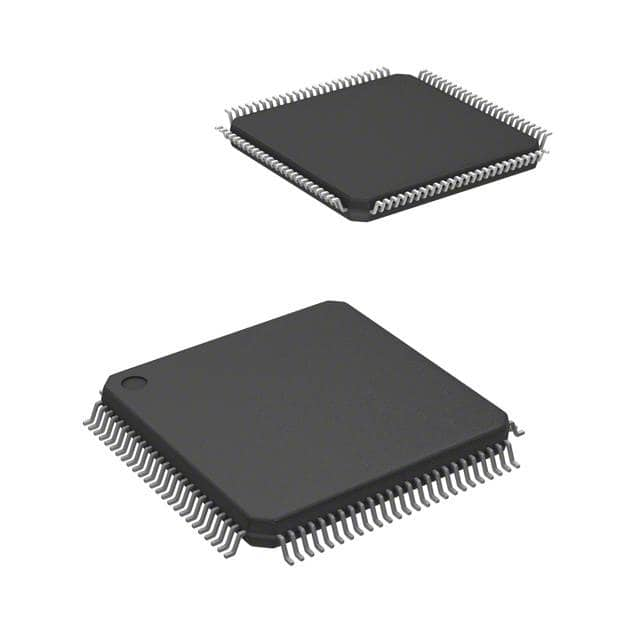Voir les spécifications pour les détails du produit.

MSP430F47176IPZR
Product Overview
Category
The MSP430F47176IPZR belongs to the category of microcontrollers.
Use
This microcontroller is commonly used in various electronic devices and systems for controlling and processing data.
Characteristics
- Low power consumption
- High performance
- Integrated peripherals
- Flexible clocking options
- Wide operating voltage range
Package
The MSP430F47176IPZR comes in a small form factor package, making it suitable for compact designs.
Essence
The essence of this microcontroller lies in its ability to provide efficient control and processing capabilities while consuming minimal power.
Packaging/Quantity
The MSP430F47176IPZR is typically packaged in reels or trays, with a quantity of 250 units per reel/tray.
Specifications
- Architecture: 16-bit RISC
- CPU Speed: Up to 25 MHz
- Flash Memory: 120 KB
- RAM: 10 KB
- Operating Voltage Range: 1.8V to 3.6V
- Digital I/O Pins: 87
- Analog Inputs: 24
- Communication Interfaces: UART, SPI, I2C
- Timers: 4x 16-bit, 1x 32-bit
- ADC Resolution: 12-bit
- Temperature Sensor: Yes
- Operating Temperature Range: -40°C to +85°C
Detailed Pin Configuration
The MSP430F47176IPZR has a total of 100 pins, which are assigned to various functions such as digital I/O, analog inputs, communication interfaces, and power supply.
For a detailed pin configuration diagram, please refer to the datasheet provided by the manufacturer.
Functional Features
- Low-power modes for energy-efficient operation
- Integrated analog-to-digital converter (ADC) for precise measurements
- Multiple communication interfaces for data exchange
- Flexible clocking options to optimize performance and power consumption
- Built-in temperature sensor for monitoring environmental conditions
Advantages and Disadvantages
Advantages
- Low power consumption enables longer battery life in portable devices.
- High-performance architecture allows for efficient data processing.
- Integrated peripherals reduce the need for external components, saving space and cost.
- Wide operating voltage range provides flexibility in various applications.
Disadvantages
- Limited flash memory and RAM may restrict the complexity of applications.
- The small form factor package may require additional measures for heat dissipation in high-power applications.
Working Principles
The MSP430F47176IPZR operates based on a 16-bit RISC architecture. It executes instructions fetched from its flash memory using a pipeline structure, enabling efficient processing. The microcontroller interacts with external devices through its various communication interfaces, allowing for data exchange. Its low-power modes and flexible clocking options contribute to energy efficiency.
Detailed Application Field Plans
The MSP430F47176IPZR finds applications in various fields, including but not limited to: - Internet of Things (IoT) devices - Home automation systems - Industrial control systems - Medical devices - Wearable technology
In these applications, the microcontroller's low power consumption, integrated peripherals, and flexible clocking options make it suitable for controlling and processing data in a reliable and efficient manner.
Detailed and Complete Alternative Models
- MSP430F47177IPZR: Similar to MSP430F47176IPZR with increased flash memory capacity.
- MSP430F47178IPZR: Similar to MSP430F47176IPZR with additional features such as more digital I/O pins and enhanced communication interfaces.
These alternative models provide options with varying specifications and capabilities, allowing designers to choose the most suitable microcontroller for their specific application requirements.
Word count: 550 words
Énumérez 10 questions et réponses courantes liées à l'application de MSP430F47176IPZR dans les solutions techniques
Sure! Here are 10 common questions and answers related to the application of MSP430F47176IPZR in technical solutions:
Q: What is MSP430F47176IPZR? A: MSP430F47176IPZR is a microcontroller from Texas Instruments' MSP430 family, designed for low-power applications.
Q: What are the key features of MSP430F47176IPZR? A: Some key features include a 16-bit RISC CPU, up to 120KB of flash memory, 8KB of RAM, multiple communication interfaces, and various peripherals.
Q: What are the typical applications of MSP430F47176IPZR? A: MSP430F47176IPZR is commonly used in applications such as industrial automation, smart meters, sensor networks, portable medical devices, and battery-powered systems.
Q: How does MSP430F47176IPZR achieve low power consumption? A: The microcontroller incorporates several power-saving modes, including standby mode, sleep mode, and real-time clock mode, which help minimize power consumption.
Q: Can I program MSP430F47176IPZR using C or assembly language? A: Yes, MSP430F47176IPZR can be programmed using both C and assembly language. Texas Instruments provides an Integrated Development Environment (IDE) called Code Composer Studio for programming and debugging.
Q: Does MSP430F47176IPZR support analog-to-digital conversion (ADC)? A: Yes, MSP430F47176IPZR has an integrated 12-bit ADC module that allows you to convert analog signals into digital values.
Q: Can I interface MSP430F47176IPZR with other devices or sensors? A: Yes, MSP430F47176IPZR supports various communication interfaces such as UART, SPI, I2C, and USB, allowing you to interface with external devices or sensors.
Q: What is the maximum clock frequency of MSP430F47176IPZR? A: The maximum clock frequency of MSP430F47176IPZR is 16 MHz.
Q: Does MSP430F47176IPZR have built-in security features? A: Yes, MSP430F47176IPZR provides hardware-based security features like a memory protection unit (MPU) and a random number generator (RNG) for secure applications.
Q: Can I use MSP430F47176IPZR in battery-powered applications? A: Absolutely! MSP430F47176IPZR is designed for low-power applications, making it suitable for battery-powered devices where power efficiency is crucial.
Please note that these answers are general and may vary depending on specific requirements and use cases.

